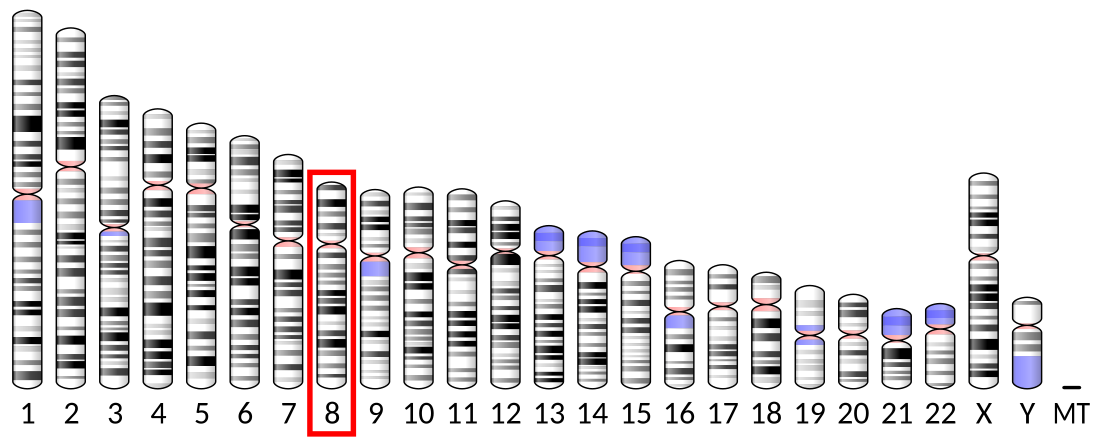Top Qs
Timeline
Chat
Perspective
Clusterin
Protein found in humans From Wikipedia, the free encyclopedia
Remove ads
Clusterin is a protein that in humans is encoded by the CLU gene on chromosome 8.[5] CLU is an extracellular molecular chaperone which binds to misfolded proteins in body fluids to neutralise their toxicity and mediate their cellular uptake by receptor-mediated endocytosis. Once internalised by cells, complexes between CLU and misfolded proteins are trafficked to lysosomes where they are degraded.[6] CLU is involved in many diseases including neurodegenerative diseases, cancers, inflammatory diseases, and aging.[7][8][9]
Remove ads
Structure
The CLU gene contains nine exons and a variety of mRNA isoforms can be detected, although most of these are only ever expressed at very low levels (< 0.3% of the total). The full-length mRNA encoding the secreted isoform is by far the dominant species transcribed.[10] Secreted CLU (apolipoprotein J) is an approximately 60 kDa disulfide-linked heterodimeric glycoprotein which migrates in SDS-PAGE with an apparent molecular mass of 75-80 kDa.[11] Mature CLU is composed of disulfide-linked α- and β-chains. Although multiple previous publications proposed the existence of N-terminally truncated CLU protein isoforms in different cell compartments, recent work has highlighted the lack of direct evidence for this [12] and shown that the full-length CLU polypeptide, with variable levels of glycosylation (and hence variable apparent mass), can translocate from the ER/Golgi to the cytosol and nucleus during stress.[13]
Remove ads
Function
Summarize
Perspective
Clusterin was first identified in ram rete testis fluid where it was shown to elicit in vitro clustering of rat Sertoli cells and erythrocytes, hence its name.[14]
CLU has functional similarities to members of the small heat shock protein family and is thus a molecular chaperone. Unlike most other chaperone proteins, which aid intracellular proteins, CLU is trafficked through the ER/Golgi before normally being secreted. Within the secretory system, CLU has been suggested to facilitate the folding of secreted proteins in an ATP-independent way.[9] The gene is highly conserved in species, and the protein is widely distributed in many tissues and organs, where it been implicated in a number of biological processes, including lipid transport, membrane recycling, cell adhesion, programmed cell death, and complement-mediated cell lysis.[7][8][9] Overexpression of secretory CLU can protect cells from apoptosis induced by cellular stress, such as chemotherapy, radiotherapy, or androgen/estrogen depletion. CLU has been suggested to promote cell survival by a number of means, including inhibition of BAX on the mitochondrial membrane, activation of the phosphatidylinositol 3-kinase/protein kinase B pathway, modulation of extracellular signal-regulated kinase (ERK) 1/2 signaling and matrix metallopeptidase-9 expression, promotion of angiogenesis, and mediation of the nuclear factor kappa B (NF-κB) pathway. Meanwhile, its downregulation allows for p53 activation, which then skews the proapoptotic:antiapoptotic ratio of present Bcl-2 family members, resulting in mitochondrial dysfunction and cell death. p53 may also transcriptionally repress secretory CLU to further promote the proapoptotic cascade.[7]
Remove ads
Clinical significance
Summarize
Perspective
Alzheimer's disease
Two independent genome-wide association studies identified a statistical association between a single-nucleotide polymorphism (SNP) in the CLU gene and the risk of developing Alzheimer's disease.[15][16]
Subsequent studies found elevated clusterin (CLU) protein levels in the blood of individuals with Alzheimer's disease, and these levels were correlated with faster cognitive decline. However, increased CLU levels did not reliably predict the onset of the disease.[17][18]
CLU may also play a role in other neurodegenerative diseases, such as Huntington disease.[8]
Cancer
CLU has been implicated in multiple cancers through its role in promoting tumor cell survival and resistance to apoptosis. It facilitates the binding of BAX to Ku70, thereby preventing BAX from localizing to the outer mitochondrial membrane to initiate apoptosis.
In clear cell renal cell carcinoma, CLU regulates ERK1/2 signaling and matrix metallopeptidase-9 expression to promote tumor cell migration, invasion, and metastasis. In epithelial ovarian cancer, CLU enhances angiogenesis and chemoresistance. It is also involved in the PI3K/AKT/mTOR pathway and NF-κB pathway, further supporting cell survival and resistance to therapy. In contrast, CLU expression is downregulated in testicular seminoma, making these tumors more sensitive to chemotherapy. CLU has also been implicated in breast cancer, pancreatic cancer, hepatocellular carcinoma, and melanoma.
Due to its central role in tumor biology, CLU has been investigated as a therapeutic target. Inhibition of CLU enhances the efficacy of chemotherapeutic agents.[7] One promising agent, custirsen, is an antisense oligonucleotide that targets CLU mRNA. It was shown to improve the activity of HSP90 inhibitors by suppressing the heat shock response in castration-resistant prostate cancer, and was evaluated in phase III trials.[7][9]
Infectious diseases
CLU is also involved in the host response to infection. In hepatitis C virus infection, CLU is upregulated in response to cellular stress and assists in viral assembly by stabilizing the viral core and NS5A proteins.[9]
Other conditions
Beyond its roles in neurodegeneration, cancer, and infection, CLU has been associated with conditions related to oxidative stress, including aging, glomerulonephritis, atherosclerosis, and myocardial infarction.[9]
Remove ads
Interactions
CLU has been shown to interact with many different protein ligands and several cell receptors.[12]
References
Further reading
External links
Wikiwand - on
Seamless Wikipedia browsing. On steroids.
Remove ads




